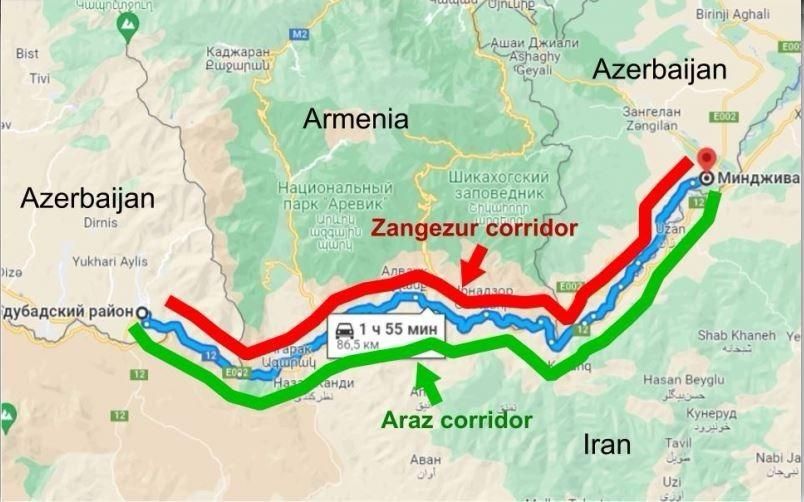Zangazur Corridor as geopolitical multiplier to link East-West and North-South trade

In a recent interview with Saudi Arabia’s Al Arabiya TV, the President of the Republic of Azerbaijan, Ilham Aliyev, presented a comprehensive vision for the Zangazur Corridor - now dubbed TRIPP (Trump Route for International Peace and Prosperity) - positioning it not only as a national priority but a transformative project for the entire region. His statements reinforced the strategic, geopolitical, and economic value of the corridor, which is expected to enhance regional cooperation, unlock new trade routes, and foster economic interdependence between Asia and Europe.
At its core, the Zangazur Corridor is designed to establish a direct connection between mainland Azerbaijan and its exclave Nakhchivan, eliminating the logistical hurdles of current detours through Iran or via Georgia and Türkiye. But as President Aliyev emphasized, the project extends well beyond national connectivity. It serves as a critical link in the wider Middle Corridor, connecting China and Central Asia with Europe through Azerbaijan.
The corridor offers a second East-West route, alongside existing transit networks through Georgia and Türkiye. In doing so, it addresses increasing cargo volumes and supply chain demands across Eurasia. “This is not only about connecting parts of Azerbaijan,” President Aliyev noted. “It is about building a new transportation line” that will be vital for intercontinental commerce.
The Zangazur Corridor represents more than a geopolitical ambition—it is an economic multiplier. Once operational, it will stimulate trade, investment, logistics, and infrastructure development not only in Azerbaijan but also in neighboring countries such as Armenia, Türkiye, Iran, and even beyond to Russia and Central Asia.
Armenia, in particular, stands to transform from a landlocked economy into a viable transit hub. As President Aliyev stressed, “Armenia will get transit fees from transportation. This is a benefit for them.” This reorientation of Armenia’s economic geography could, if properly managed, reduce historical tensions and integrate the country into regional value chains, increasing its political and economic stability.
President Aliyev emphasized the importance of international security guarantees, noting that trust in the corridor's safety is crucial for its effective operation. The involvement of the Trump administration, which backed the concept of TRIPP, signals growing interest from Western actors in ensuring the corridor’s implementation.
Although there is no confirmed agreement yet, American investors have been floated as potential contributors to the infrastructure financing - signaling the corridor’s investment potential and international visibility.
President Ilham Aliyev made clear that Azerbaijan has completed the necessary infrastructure on its own territory, and that it is now Armenia’s responsibility to fulfill its commitments. “If we were to build it ourselves, we would have done it in one year,” he said, pointing to Azerbaijan’s comparative advantage in infrastructure readiness.
Complementary, not competitive: Cooperation with Iran and Russia
Addressing concerns about how the corridor might impact Iran, President Aliyev dismissed the idea that the Zangezur project poses any strategic threat. “We are not a country which occupies… Our war was a just war, a war of restoration,” he stated. Contrary to narratives about Azerbaijan attempting to cut off the Armenian-Iranian border, Ilham Aliyev explained the collaborative efforts with Iran, including the parallel development of the Araz Corridor, a bypass through Iranian territory into Nakhchivan.
Far from undermining Iran’s strategic interests, Zangazur and Araz Corridors can complement Iran’s North-South transport ambitions. By adding an additional route to the International North-South Transport Corridor (INSTC), the Zangezur project enables cargo movement between Northern Europe, Russia, Azerbaijan, and the Persian Gulf —further diversifying and securing logistics flows.
President Aliyev framed this development as a "win-win" for all stakeholders: “Instead of one North-South route from Russia to Iran through Azerbaijan, we will have another… through Armenia and Nakhchivan.”
In rebranding the corridor as TRIPP - Trump Route for International Peace and Prosperity - President Aliyev underscored the project’s broader ambition: to become a model of regional integration and peaceful coexistence. Rather than being a tool of domination or exclusion, the Zangazur Corridor is positioned as an inclusive infrastructure for economic growth, mutual benefit, and stability.
Critically, its success hinges on political will, diplomatic coordination, and multilateral cooperation. With rising geopolitical tensions globally, TRIPP represents a rare opportunity: a project where economics can outpace politics, and where historical grievances may give way to pragmatic partnership.
The Zangazur Corridor, as articulated by President Ilham Aliyev, is not just a transport route - it is a strategic artery of connectivity, a symbol of national resilience, and potentially, a catalyst for regional transformation. If realized with cooperation and foresight, it will redefine trade dynamics between East and West, North and South - delivering economic dividends to all nations along its path.
In an era where global supply chains are being restructured and regional alliances reshaped, Zangezur offers a powerful case study: that infrastructure can be diplomacy, and that corridors can become bridges, not boundaries.
Here we are to serve you with news right now. It does not cost much, but worth your attention.
Choose to support open, independent, quality journalism and subscribe on a monthly basis.
By subscribing to our online newspaper, you can have full digital access to all news, analysis, and much more.
You can also follow AzerNEWS on Twitter @AzerNewsAz or Facebook @AzerNewsNewspaper
Thank you!

